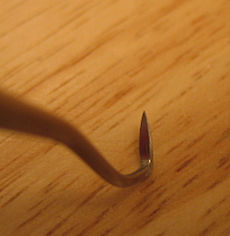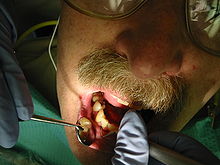- Scaling and root planing
-
Scaling and root planing Intervention 
Close-up image of a hand scaler.ICD-9-CM 96.54 MeSH D012534 The objective of scaling and root planing, otherwise known as conventional periodontal therapy, non-surgical periodontal therapy or deep cleaning, is to remove or eliminate the etiologic agents which cause inflammation: dental plaque, its products and calculus,[1] thus helping to establish a periodontium that is free of disease.[2]
Contents
Plaque
Plaque is a soft, sticky mixture of bacteria, waste products from bacteria, and some food debris. It irritates the gums, or gingiva, and causes inflammation over time: gingivitis. The longer plaque is left on the teeth, the harder it gets. After 24 hours, some plaque hardens into calculus, otherwise known as tartar. Calculus is mineralized plaque and does not come off with the brush and floss anymore. The bacteria in plaque and calculus causes an ongoing state of inflammation called gingivitis. If left untreated, gingivitis can progress to a more serious disease called periodontitis. The most common treatment for periodontitis is Scaling and Root Planing.
Plaque build up and bone loss
Because the bone is alive, it has cells in it that build bone, and cells that break down bone. Usually these work at the same speed, and keep each other in balance: it is called bone remodeling. The chemical by-products of ongoing inflammation stimulate the cells that break down bone, which now start working faster than the cells that build bone. The net result is that bone is lost, and the loss of bone and attachment tissues is called periodontal disease.
Periodontal scaling
Periodontal scaling procedures "include the removal of plaque, calculus and stain from the crown and root surfaces of teeth. Root planing is a specialized skill involving scaling of the root of the tooth, made up of cementum. Because cementum is softer than enamel, it is affected more by ongoing build-up and inflammatory byproducts. A smooth cementum provides less opportunity for bacteria to hang out and form calculus, so root planing is an important part of stopping periodontal disease where it is at, and preventing periodontal disease from getting worse, specially once deeper pockets have formed in the gums, which is really in the bone. So, root planing is a specific treatment that removes the roughened cementum and surface dentin that is impregnated with calculus, microorganisms and their toxins."[2]
Because in periodontal disease pockets form that are deeper than the usual gingival depth, such scaling and root planing are often referred to as deep cleaning, and may be performed using a number of dental tools, including ultrasonic instruments and hand instruments, such as periodontal scalers and curettes.
Removal of adherent plaque and calculus with hand instruments can also be performed on patients without periodontal disease. This treatment would then be referred to as a prophylaxis. A prophylaxis (a preventive cleaning, literally it means "action taken to prevent disease") or a prophy for short refers to scaling and polishing of the teeth in order to prevent oral diseases. Polishing does not remove calculus, only some plaque and stains, and should therefore only be done in conjunction with scaling.
Sometimes a device may be electric, known as an ultrasonic or sonic scaler. Ultrasonic scalers vibrate at a frequency that breaks down bacterial cell membranes and removes both plaque and calculus. Hand instruments are used to complete the fine hand scaling that removes anything the ultrasonic scaler left behind.
Sonic and ultrasonic scalers are powered by a system that causes the tip to vibrate. Sonic scalers are typically powered by an air-driven turbine. Ultrasonic scalers typically use either magnetostrictive or piezoelectric systems to create vibration. Magnetostrictive scalers use a stack of metal plates bonded to the tool tip. The stack is induced to vibrate by an external coil connected to an AC source. Ultrasonic scalers also include a liquid output or lavage, which aids in cooling the tool during use, as well as rinsing all the unwanted materials from the teeth and gum line. The lavage can also be used to deliver antimicrobial agents.
There is some debate over whether there is an advantage to sonic or ultrasonic scaling over hand scaling and some issues arise from powered scalers.[citation needed] Although the final result of ultrasonic scalers can be produced by using hand scalers, ultrasonic scalers are sometimes faster and less irritating to the client. Ultrasonic scalers do create aerosols, which can spread pathogens when a client carries an infectious disease. Relying solely on ultrasonic scalers for all scaling is inadequate; it is best to follow ultrasonic scaling with hand scaling. Of particular importance to dentists themselves is that use of an ultrasonic scaler will greatly decrease their likelihood of getting Carpal Tunnel Syndrome (Or other similar forms of RSI).[citation needed]
Effectiveness
Scaling and root planing is considered the basic treatment of periodontal diseases and may be the only treatment required to treat mild cases of periodontitis; however, it may also be the initial therapy prior to future surgical needs. For the procedure to be considered effective, the patient must be able to be maintained at a level of periodontal health that will prevent reinfection with periodontal pathogens periodontal disease[3]. This requires optimal home care and ongoing periodontal maintenance therapy, usually every 3 to 4 months to sustain health.
See also
- Tooth polishing
- Debridement (dental)
- Periodontal disease
References
- ^ Grant, DS, Stern IB Periodontics, 6th Edition, CV Mosby and Co. St. Louis 1988.
- ^ a b Giusto, T. Non-surgical vs. surgical periodontal therapy, SUNY Stonybrook, June 1997, page 1
- ^ Robert J. Genco; Henry Maurice Goldman; David Walter Cohen (1990). Contemporary periodontics. Mosby. ISBN 978-0-8016-1935-9. http://books.google.com/books?id=nO5pAAAAMAAJ. Retrieved 20 September 2011.
External links
- What is Deep Cleaning (Scaling and Root Planing)?
- Dickson, Murray (July 1996) [1983]. "Scaling Teeth" (pdf). Where There Is No Dentist (7th printing ed.). Palo Alto, CA: The Hesperian Foundation. pp. 121–128. ISBN 0-942364-05-8. http://www.healthwrights.org/books/WTINDent/WTINDchapt8.pdf. Retrieved March 2006.
Periodontology Tissues of the periodontium
and their physiologic entitiesAlveolar bone · Biologic width · Bundle bone · Cementum · Free gingival margin · Gingiva · Gingival fibers · Gingival sulcus · Junctional epithelium · Mucogingival junction · Periodontal ligament · Sulcular epithelium · StipplingDiagnoses Chronic periodontitis · Localized aggressive periodontitis · Generalized aggressive periodontitis · Periodontitis as a manifestation of systemic disease · Necrotizing periodontal diseases · Abscesses of the periodontium · Combined periodontic-endodontic lesionsPathogenesis A. actinomycetemcomitans · Capnocytophaga sp. · F. nucleatum · P. gingivalis · P. intermedia · T. forsythia · T. denticolaPathologic entities Calculus · Clinical attachment loss · Edentulism · Fremitus · Furcation defect · Gingival enlargement · Gingival pocket · Gingivitis · Horizontal bony defect · Linear gingival erythema · Occlusal trauma · Periodontal pocket · Periodontal disease · Periodontitis · Plaque · Recession · Vertical bony defectDiagnosis, treatment planning,
prevention and
chemotherapeutic agentsBrushing · Bleeding on probing · Chlorhexidine gluconate · Enamel matrix derivative · Flossing · Hydrogen peroxide · Mouthwash · Oral hygiene · Tetracycline · TriclosanPeriodontal armamentarium Conventional therapy Surgical therapy and
periodontal surgeryApically positioned flap · Bone graft · Coronally positioned flap · Crown lengthening · Open flap debridement · Free gingival graft · Gingivectomy · Guided bone regeneration · Guided tissue regeneration · Implant Placement · Lateral pedicle graft · Pocket reduction surgery · Sinus lift · Subepithelial connective tissue graftImportant personalities Per-Ingvar Brånemark · Jan Lindhe · Preston D. Miller · Willoughby D. Miller · Carl E. Misch · John Mankey Riggs · Jørgen Slots · Dennis P. Tarnow · Hom-Lay Wang · James Leon Williams · W. J. YoungerOther specialties Endodontology · Orthodontology · Prosthodontology
This dentistry article is a stub. You can help Wikipedia by expanding it.


